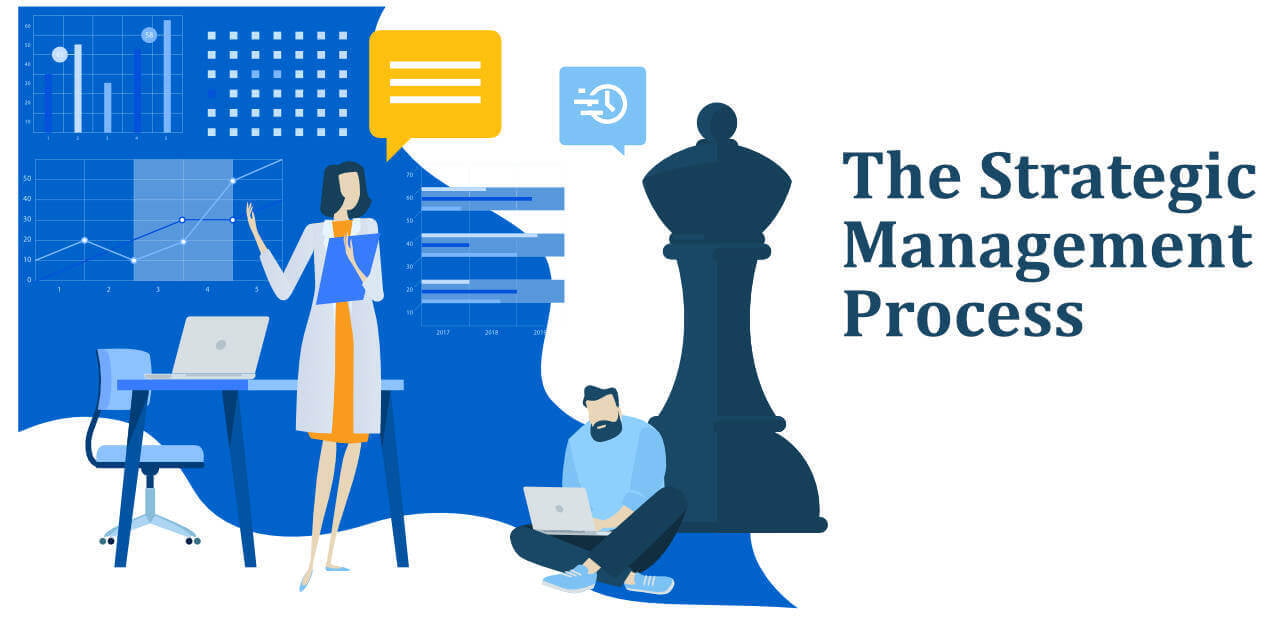
Many managers of large and small companies integrate apps and software into the strategic planning process to create a simplified roadmap, but it rarely that simple. The steps in the strategic planning process are comprehensive and focused on key strategic objectives. They help get you a clear idea of what you should be aiming for and which initiatives provide less value to your business.
The Strategic Management Process
The Strategic Management Process
Strategic planning is a multi-stage planning process that defines the scope and duration of a project. It consists of several key components, including objectives, goals of the organization, targets, set of strategic objectives, as well as a plan of how often it is reviewed and updated. Effective strategic planning requires the collective effort of every team member. It also requires the cooperation of the management team. It involves clarifying the strategic position, defining goals, developing and implementing plans, and evaluating and measuring these plans. The company must have its own goals and must also be able to respond to changes.
The Strategic Management Process
The Strategic Management Process
The strategic management process is more than just a set of rules to follow; it is a philosophical approach to economics. Strategic planning and management of a company's strategic position is a philosophy of management and not just an exercise in economics or management theory. It is best implemented so that everyone in the company understands the strategy. The managers must first think strategically and then apply this thought to the process. The first step in developing a strategy is to review all the information obtained during the analysis. Identify where the company needs to call for external resources and determine what resources it currently has to help achieve the goals you have defined. Prioritize the problems your company faces because of their importance to success.
Once the priorities are set, you start formulating a strategy. Here you are in the action phase of the strategic management process. The business and economic situation is in flux and the successful implementation of your strategy is crucial for the success of your company. It is also crucial that you develop an alternative approach that aims at the step-by-step plans. If the overall strategy does not work with the current corporate structure, a new structure should be installed. Everyone in the organization must be aware of how their responsibilities and duties fit in with their general objectives. It is also important to safeguard the resources and finance the project. Once the funding is in place and the staff is ready, the plan can be implemented in a timely manner.

1. Clarify Strategic Position
1. Clarify Strategic Position
The strategic planning process is best understood through the lens of your company's mission, goals, and objectives, as well as the goals of the organization as a whole. Before you use it as a guide to your organization's efforts, remember that there is no single approach to strategic planning. There is no right or wrong way to strategic planning. Set your strategic position, define goals, develop and implement the plan, evaluate and measure goals, and make a clear path in advance so you know how you want to proceed.
Mission
Mission
Take the time to develop a mission statement and treat it as if you were writing a book. Let outsiders read it and tell you what they understood. Take a critical look at your current statement, work with your team on several drafts, and take time to develop your mission statements. Create a mission statement that describes the purpose of the organization. It should tell its customers, employees, and others what it is committed to doing. Your mission and goals should serve as a guide in measuring your performance and orients the objectives so that it is in line with the corporate strategy.
Vision
Vision
Consider how long your strategic plan is for and write a short paragraph about where you want to be and what goals you have to support your vision. Think about your mission statement and how you want to achieve this goal in the future.

Within the framework of the strategic planning process, you must also identify internal processes and situations that may influence you in the future and your ability to execute as planned. Although an organization cannot predict all possible changes before it creates a strategic plan, you should take steps in the strategic planning process to ensure that the plans you create are flexible enough to handle unexpected changes.

Resources
Resources
Develop an action plan that informs your employees and makes them responsible for the results. Taking into account internal and external sources, you need to involve the right players from the outset. This phase of preparation prepares the ground for the progress of the work and helps you to understand your internal and external strategies. This is helpful because you can decide where to go and how to get there.
Competition
Competition
Identify the most important competition issues by talking to business managers by gathering customer input, and gaining a better overview of the market and the role of your customers. Use the SWOT analysis as a framework for your initial assessment and as a basis for developing an action plan.
Goal Setting
Goal Setting
Set goals once your current market position is established and help meet expectations which are clear and quantifiable to help you achieve the long-term strategic goals and initiatives identified in step one. This phase consists of identifying short- and long-term objectives; firstly, to set out the objectives and secondly, to establish the process for achieving them. The objective is to clarify the vision of the company and to adapt the processes to the employees by giving each one a task to complete.
Analysis
Analysis
A careful analysis is the key to this phase because the information it provides will shape the next two phases. The resulting insights should be detailed, realistic and in line with values and visions. As a rule, the last step in the phase is to write a mission statement that gets to the heart of the goals for shareholders and employees.
The analysis should focus on understanding the current state of the company, its financial situation, and prospects and identifying initiatives that will help it grow. Gather all the information relevant to the implementation of this vision, such as the business plan, financial data, strategic plans, business strategy, and other relevant information. Check any external or internal issues that may affect your goals and objectives, and make sure you recognize any threats or opportunities that may arise along the way.

2. Set and Prioritize Objectives
2. Set and Prioritize Objectives
This helps to create a list of strategic objectives to pursue and determine which initiatives are low priority. These steps provide officials with a framework to ensure a rigorous approach to strategic planning that effectively prioritizes the successful implementation of critical initiatives, while functional strategic plans are calendar-based and more akin to a constant reassessment of priorities. Next, we explain the process of setting and planning objectives. This is the method used by organizations to develop a strategic plan to achieve long-term goals.
SMART Goals
SMART Goals
Whether it is setting timetables, capital, and resources, or specific goals that are consistent with your organization's mission and direction, smart goals are the best way to achieve and measure success. This phase will determine your strategy for achieving your goals and set timetables for effective communication of responsibilities.
3. Strategy Assessment and Implementation
3. Strategy Assessment and Implementation
A successful evaluation of a strategy begins with the definition of the parameters to be measured. This includes measures to evaluate and control the strategy. The actual progress is determined by comparing actual results with those in the plan. If the measures are not successful, the strategic management process is repeated and corrected to find out whether the strategy is not moving the company in the direction of its goals. Monitoring internal and external problems also allows you to respond to significant changes in your business environment. An important part of the strategic planning process is to assess the skills of the employees and see if they can achieve the goals they require. As internal and external issues evolve, the data collected during this phase can be stored to help you with future strategies. Errors in the early stages of your strategic plan can have significant negative effects and consequences later on.
4. Strategy Development
4. Strategy Development
This step one is also called strategy implementation, i.e., the process of defining a general approach. In this step of the strategic planning process, managers are faced with the question of what is required for the new strategy and what kind of strategy it will be, as well as what are the steps in the implementation of the strategy.
The strategic planning process is a method used by organizations to develop a strategy to achieve general and long-term goals. There are several other aspects of the planning process that can be incorporated into the creation of a business strategy. Methods vary from a project planning approach, where the organization and delegation of assignments are used for specific projects, to strategic planning, which allows you to define a purpose, vision, and goals for the entire organization.

Strategy mapping is an excellent tool to visualize your entire plan. Everyone in your organization might tend to work harder to achieve their goals. This also allows you to track your market operations and find opportunities for progress. External factors are also crucial to the quality of the strategy, such as market conditions, the business environment, and external factors. Strategic planning must be flexible, as strategies should change over time, especially in light of changing business conditions. Effective implementation of a strategy is a key to the growth of your business and, as market and economic conditions are dynamic, the creation of alternative solutions is crucial.
5. Monitor and Evaluate Your Strategy
5. Monitor and Evaluate Your Strategy
The final step in the strategic planning process involves generating the necessary feedback to implement the strategy. This includes evaluating the implementation of a strategic plan retrospectively and assessing its impact on the business. Measures and accountability are as important to the success of a strategic plan and its implementation. It is also important to hold those involved in this strategic plan process accountable for the tasks they are assigned and their performance.
If the cumulative strategy does not match the existing business activities, a new structure for the strategy should be explored. By mapping the process, you can translate a comprehensive strategy into a concrete plan. Use KPI dashboards to effectively communicate your team's responsibilities and track progress. A successful strategic assessment begins with the definition of the parameters to be measured, including the measures to evaluate and control the strategy. The priorities of the strategic plan can be reviewed and revised to take into account new business adjustments and ensure that the objectives are based on the ever-changing environment within the organization.
Consider a Strategy Consultant
Consider a Strategy Consultant
When you work with a strategy consultant, you will learn whether strategic planning makes sense for your company and how to effectively integrate your team into the process. A consultant can help you maximize your potential as a business on your next strategy meeting. Contact us at Universal Creative Solutions for our strategic planning services or to learn more about how we can help you get started with your plans. A strategy consultant will help you develop bespoke solutions for your business and measurable goals throughout the strategic planning process; we want you to select someone who understands your mission and has the ability to get the job done before you even start working together. In summary, following the steps of the strategic planning process does not guarantee that you will make the right decisions or that your strategy will be implemented properly. Before you plan your next move, remember that truly effective strategic planning requires a strong understanding of your company's mission, goals, as well as a clear vision for the future.


